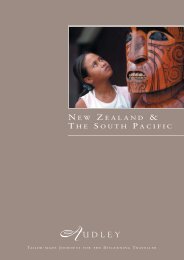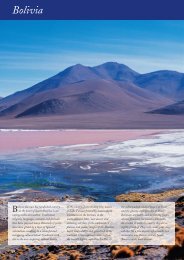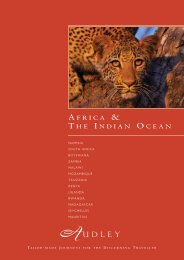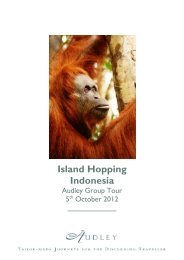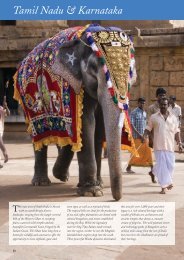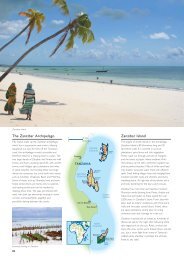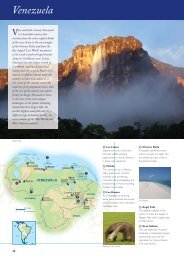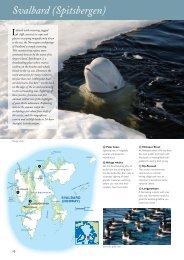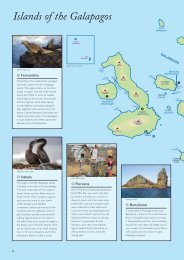Download - Audley Travel
Download - Audley Travel
Download - Audley Travel
You also want an ePaper? Increase the reach of your titles
YUMPU automatically turns print PDFs into web optimized ePapers that Google loves.
Wildlife<br />
Canada and Alaska are known for their<br />
huge tracts of pristine wilderness, the<br />
sheer scale of which has done much to protect<br />
the abundant concentrations of animals.<br />
Close encounters with wildlife are frequently<br />
superb. The nutrient-rich seas attract some of<br />
the world’s greatest concentrations of seabirds<br />
but also support countless marine mammals:<br />
Canada’s coast can offer some of the world’s<br />
best whale sightings. On land the large<br />
mammals comfortably outnumber the<br />
human population. Here it is possible to see<br />
polar bears hunt from ice floes, black bears<br />
slouch through the woods and grizzly bears<br />
fish salmon out of fast-flowing rivers.<br />
Bison still congregate in herds while elk,<br />
moose, caribou and musk oxen provide<br />
thrilling encounters.<br />
Bears<br />
One of the delights of travelling in Canada and<br />
Alaska is the very real chance that you will see a<br />
bear. The two species that you are likely to<br />
encounter are grizzly and black bears. Black bears<br />
are smaller than the grizzly and lack the distinctive<br />
hump on the back of the neck. In the spring,<br />
bears emerge from hibernation to mate and to<br />
feed. Their diet consists of all kinds of vegetable<br />
matter including berries, flowers, grasses and<br />
sedges as well as fish, insects, honey and even<br />
elk and moose. The largest populations of grizzly<br />
bears are in Alaska, British Columbia and the<br />
Northwest Territories. Kodiak Island in Alaska<br />
is renowned for being home to the largest<br />
grizzlies in the world while nearby Brooks Falls<br />
in Katmai National Park is home to the thrilling<br />
spectacle of grizzlies catching salmon as they<br />
leap up the falls. The rare kermode, or spirit bear,<br />
is unique to remote parts of coastal British<br />
Columbia and due to a recessive gene has a<br />
distinctive white coat. These bears, related to<br />
black bears, are agile salmon catchers and are<br />
a thrill to see in their natural setting.<br />
Polar Bears<br />
One of the most thrilling sights in the Arctic is to<br />
see Ursus Maritimus, the world’s largest bear, in<br />
its native environment. In the autumn bears<br />
congregate near the small northern Manitoba town<br />
of Churchill waiting for the ice to freeze in order<br />
to hunt for seals. During the summer months polar<br />
bears are seen at the mouth of the Seal River on<br />
Hudson Bay and in the vast and untamed lands of<br />
the northern tundra where small ship cruises and<br />
specialist lodges offer thrilling opportunities to see<br />
these magnificent bears in their natural habitat –<br />
often swimming or foraging amongst the fireweed.<br />
Wolves<br />
Often vilified and hunted almost to extinction, there<br />
are now estimated to be over 50,000 wolves across<br />
Canada and Alaska, occupying over 80 percent of<br />
their original range. The grey wolf is also known as<br />
the timber wolf and prefers the open tundra and<br />
forest habitat where it will live in packs of five to<br />
twenty animals, depending on the abundance of<br />
prey. Their main food sources are moose and elk<br />
which they hunt in teams, primarily at night. You are<br />
most likely to see wolves at dawn or sunset but<br />
10



